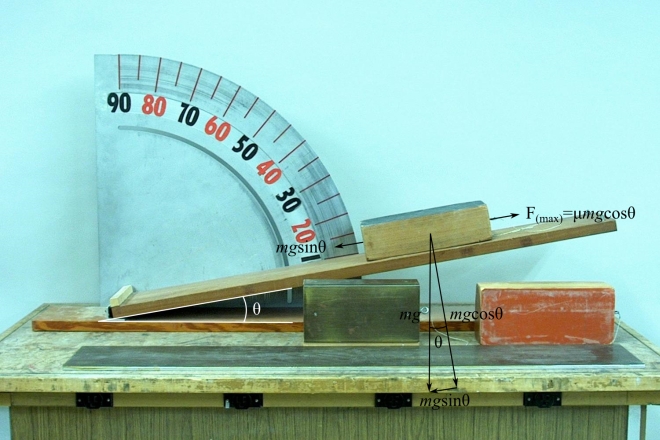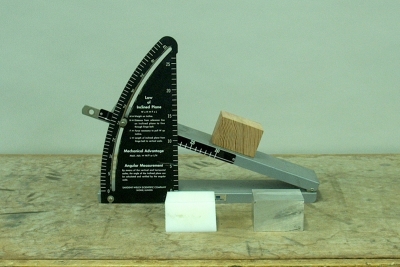
A video of this demonstration is available at this link.
Note: A smaller verion of this demonstration, shown below, is available for use in classrooms outside the Broida lecture hall building.

A video of this demonstration is available at this link.
Note: A smaller verion of this demonstration, shown below, is available for use in classrooms outside the Broida lecture hall building.
Three blocks are available for sliding down the incline, two wooden blocks and one made of aluminum. One wooden block has sandpaper on one face and mylar on the opposite face. The other has silicone rubber on one face, and the other face is bare. The aluminum block has one wooden face and edge, and one brass face and edge. In addition, there is an aluminum plate, clad with brass on one face, which you can place on top of the incline to change the material on which the blocks slide. Two holes in the plate engage the ends of the screws at the free end of the incline.
The purpose of this demonstration is to demonstrate static friction. As noted in the explanation for demonstration 12.66 -- Pull friction block with spring scale, static friction is the force generated between the surfaces of two objects in contact with each other, which opposes any applied force that would accelerate one object relative to the other. It acts opposite to the direction of this applied force, and depends linearly on the force that acts to keep the two surfaces together (which is perpendicular to the applied force). If you increase the magnitude of the applied force, static friction balances it until it exceeds the static friction, and the object begins to slide relative to the other one. At this point, the friction that acts is sliding friction, or kinetic friction, which is somewhat smaller in magnitude than static friction.
In this demonstration, you start with the plane horizontal and place one of the blocks on it. As you then lift the incline, the block is subject to the forces shown in the photograph. These are gravity (= mg), which has a component perpendicular to the inclined plane (mg cos θ) and a component parallel to the plane (mg sin θ), and static friction, which equals μsmg cos θ and opposes mg sin θ. (Not shown is the normal force, opposite to and in line with mg cos θ, with which the board pushes upwards on the block.) Static friction balances any applied force that would accelerate the block relative to the plane, until that force exceeds it. For this reason, it appears in the photograph with the subscript “(max).” As you continue to raise the incline, mg cos θ (and thus μsmg cos θ) decreases, and mg sin θ increases, until the downhill component of gravity equals the static friction, or mg sin θ = μsmg cos θ. From this we see that sin θ = μ cos θ, or μs = sin θ/cos θ = tan θ. Thus, if you tilt the incline until the block just begins to slide, then measure the angle at which this happens, you can calculate the coefficient of static friction for the block on the incline. A wingnut on the back of the incline allows you to fix the angle if you wish.
You can also determine μk, the coefficient of kinetic friction, by finding the angle of the inclined plane for which the block, after you start it with a tap, slides down the plane with a constant speed. In this situation, the kinetic friction balances the component of gravity that is parallel to the plane, and as above, the tangent of the angle gives the coefficient of kinetic friction.
The variety of available block and incline surfaces allows you to change these and see how the coefficient of static friction varies with different pairs of surfaces.
While this demonstration is transportable by cart, another, much smaller apparatus is available, which can be carried to a remote classroom:

This apparatus is adjustable from 0 to 45 degrees. A knurled nut allows you to lock the incline at a particular angle. A scale along the outer edge allows you to read the angle directly. A linear scale on the incline, which reads distance from the hinge in centimeters, and a vertical scale that reads height in centimeters, allow you to calculate the sine of the angle (and cosine, if you note the distance at zero degrees). Three blocks, made of wood, aluminum and polyethylene, allow you to show the variation in coefficient of static friction for these materials on the incline, which is made of enameled steel.
References:
1) Resnick, Robert and Halliday, David. Physics, Part One, Third Edition (New York: John Wiley and Sons, 1977), p. 101 (Example 1).